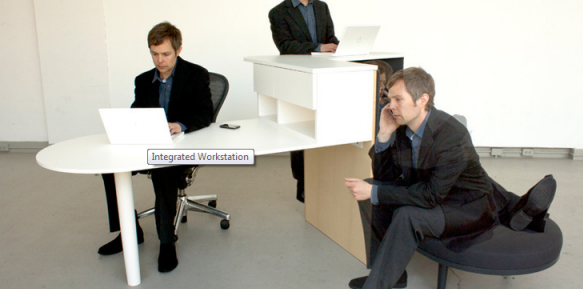To have an open office floor plan or not to have an open office floor plan… that is a question more and more offices are now facing. Over the past decade, we’ve seen the proliferation of the open office floor plan. The idea is that by having everyone sit together in one large space, it will increase the flow of communication, collaboration, and team building between employees. However with companies like Facebook taking the open office floor plan to a new extreme, there’s new evidence surfacing that maybe open offices aren’t as cracked up as we once thought they were.
Headphones Are The New Wall
“Headphones are the new wall,” says Raj Udeshi in a May New York Times article. Look around and odds are you’ll quickly spot several co-workers with headphones in their ears listening to music. Why? Isn’t the benefit of an open office increased communication? Turns out that people tend to “have shorter and more superficial conversations in open offices because they’re self-conscious about being overheard,” says Anne-Laure Fayard, a professor of management at the Polytechnic Institute of New York University who has studied open offices.” As a result of having a greater number of these shorter, more colloquial conversations take place at the office. The noise level at the workplace is higher. It’s this noise, particularly from conversations that is driving employees crazy.
According to a survey of 65,000 people over the past decade in North America, Europe, Africa and Australia conducted by the University of California, Berkeley, Center for the Built Environment, the noise generated by these floor plans is unbearable. “Noise is the most serious problem in the open-plan office, and speech is the most disturbing type of sound because it is directly understood in the brain’s working memory,” says Valtteri Hongisto, an acoustician at Finland’s Institute of Occupational Health. According to his research, the effect of being bombarded by conversations results in a 5% – 10% drop in performance of cognitive tasks requiring efficient use of short-term memory, like reading, writing and other forms of creative work. This is why today, we’re seeing more and more employees look to headphones as their new walls so they can actually get work done.
Meeting Rooms Don’t Get The Job Done
I know what you’re thinking: “If it’s too noisy, then why aren’t people using conference rooms to talk or accomplish their work?” Dr. Fayard believes that “People feel self-conscious, as if they’re retreating to the room to hide something or to talk about some problem. It’s often better to have a mix of proximity and privacy by having an in-between space, like an alcove where people can go for a quick chat.”
Herman Miller + Sound Masking = Happy Workers
The famous Michigan manufacture Herman Miller has recently tapped several industrial design students in an attempt to help find a solution to this problem. The company has selected six original seating and workstation designs and has turned them into full-scale prototypes. These prototypes are aimed at encouraging places for employees to rejuvenate and concentrate in today’s workplace. So far Herman Miller has helped submit the six designs for an exhibit at the International Contemporary Furniture Fair (ICFF) in New York earlier this year.
If new office furniture is a little too costly for your budget, another popular alternative organizations are employing is sound masking. Sound masking is the idea of using white noise as soft background noise to help dampen noise – it has a very low, hum similar to a ventilation system. It’s based on the principle of physics that when soft background noise is added to a room, the conversations and noises in the room are less understood. Don’t believe me? Autodesk tried out a sound masking system in their new Massachusetts office for three months without telling employees and then decided to turn it off for a day to see what would happen. “We were surprised at how many complaints we got,” said Charles Rechtsteiner, Autodesk’s facilities manager. “People weren’t sure what was different, but they knew something was wrong. They were being distracted by conversations 60 feet away.”
As the tools we use to accomplish work continue to evolve, so will the environments in which employees accomplish their work. It’s always going to be a bit of an experiment for organizations. Do you work in an open-plan office? Do you enjoy it, or find it frustrating? What strategies does your company use to help keep the noise at bay?

